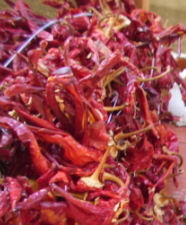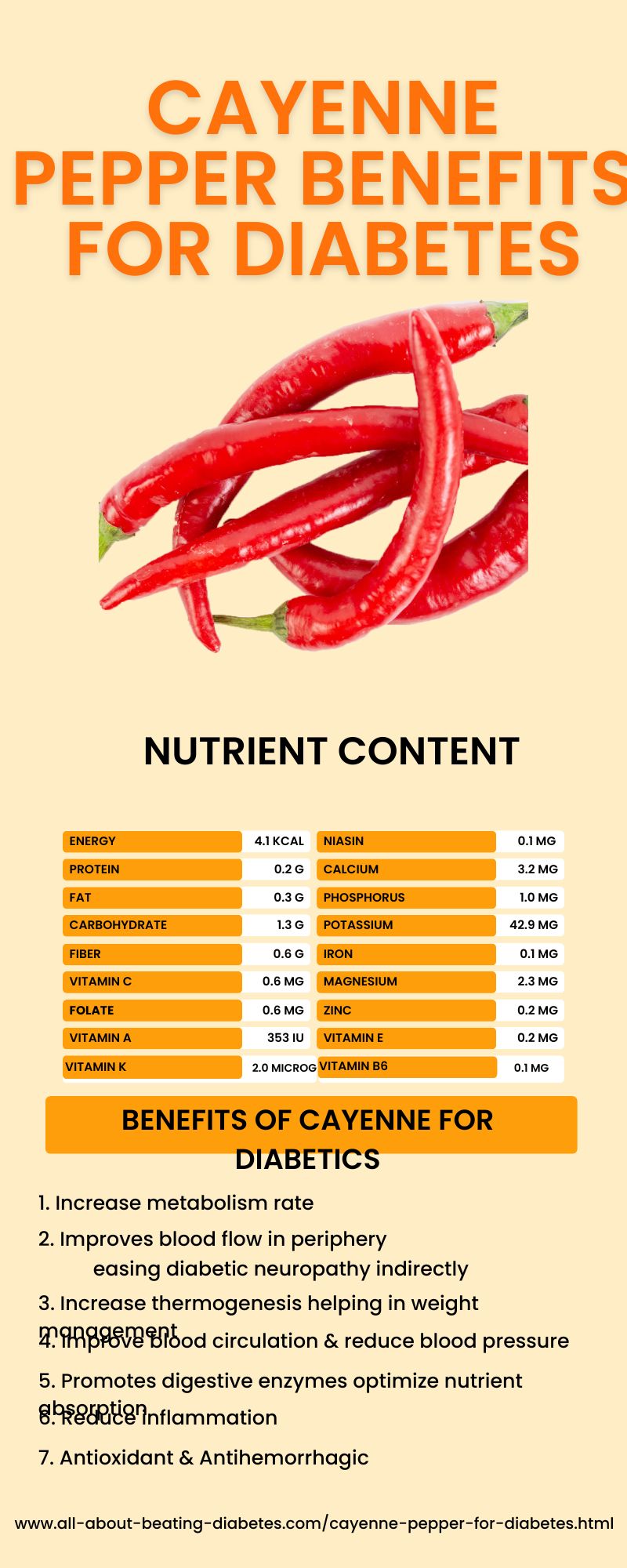Cayenne Pepper for Diabetes
What is Cayenne Pepper?

Cayenne pepper is a hot, spicy chili pepper used to flavor dishes and provide health benefits.
Made from dried and ground red chili peppers, it belongs to the Capsicum annum family and is known for its vibrant red color and pungent heat. Its other names include: African red pepper, Spanish pepper, bird pepper, Guinea pepper, or American red pepper.
Commonly used in cooking worldwide, it adds a fiery kick to soups, sauces, meats, and spice blends. Cayenne contains capsaicin, the compound responsible for its heat, which is also linked to pain relief and metabolism-boosting properties. Available as a powder or in whole dried form, cayenne pepper is both a culinary and medicinal staple in many cultures.
Benefits of cayenne pepper for diabetes control
Basically, cayenne indirectly interferes in diabetes control.
- The major impact is that cayenne can increase your metabolism rate (speed), helping you to also lose weight.
- Next, as cayenne improves the blood flow from top to toe, it indirectly eases this diabetes complication (distal neuropathy).
- Beside diabetes, cayenne has been shown very effective in stopping the hemorrhage.
- In fact, it has been shown in clinical trials that in cases of any hemorrhage emergency (like for example in your lungs, stomach, etc); giving a teaspoon of cayenne pepper powder every 15 minutes can help stop the hemorrhage.
Some doctors practice keeping cayenne capsules with them in case they face any heart attack or any other vascular emergencies.
- Furthermore, recurrent skin disorders are common among diabetes. If applied locally in form of powder, cayenne can help you get rid of them.
- With regards to the lowering blood sugar effect, there is one study giving some traces of evidence of improved insulin sensitivity in diabetics who consumed capsaicin the active component of cayenne.
Is cayenne pepper safe for diabetics?
Cayenne pepper, in moderation, is generally safe for diabetics.
However, individual responses vary, and excessive consumption may cause digestive issues.
As a diabetic, you should monitor your blood sugar levels and consult your healthcare provider before incorporating cayenne pepper into your diet to ensure it aligns with your overall diabetes management plan.
What are the potential effects of cayenne pepper on insulin sensitivity?
Cayenne pepper, containing capsaicin as its active compound, may potentially enhance insulin sensitivity.
Capsaicin has been studied for its effects on glucose metabolism and insulin action.
It could activate transient receptor potential vanilloid 1 (TRPV1) channels, leading to increased glucose uptake and improved insulin sensitivity in adipocytes.
Furthermore, capsaicin may help regulate glucose levels by reducing oxidative stress and enhancing sirtuin 3 expression in pancreatic beta-cells.
However, research is ongoing, and while promising, more human studies are needed to firmly establish the effects of cayenne pepper on insulin sensitivity and its potential benefits for individuals with diabetes.
How to use cayenne?
I should ask for your attention regarding the use of cayenne:
It's important to approach cayenne use with caution!!!
Since your body may not be accustomed to the taste of cayenne, it's advisable to begin with small amounts and gradually increase the quantity to allow your palate to adjust.
- There are various ways you can use to get the benefits of cayenne pepper. You may use the cayenne pepper powder for not only its flavoring purposes, but at the same time, getting profit of its medicinal properties.
- Another way you may profit from cayenne is by preparing a delicious lemon cayenne pepper detox drink. How? Follow the steps below.
Simple Recipe: Lemon Cayenne Pepper Detox Drink

Step no.1
Put 5 oz of water in a cup or container.

Step no.2
Then, put in two tablespoons of lemon squeeze without pulp and seeds.

Step no.3
Next, add 1/10 teaspoon ground cayenne pepper.
The last and the most important step is to “taste” this nice lemon cayenne pepper detox drink.
Make sure you take at least 6 times a day for better effects.
Where to find cayenne pepper?
As I mentioned at the beginning of this page, you can find it at any local store.
As it is mostly used in its powder form; I think it could be difficult for you to prepare the fresh one with your hands.
You can also find the cayenne powder at the local store.
However, as the pharmaceutical machinery has moved forward; it has come out with the extract of the cayenne pepper for diabetes control purposes (i.e. in doses that help a diabetic as mentioned above).
What is the right dosage to use?
The usual dose is a capsule of 450 mg of cayenne pepper extract, up to 3 times a day
What precautions to take while using Cayenne?
Stomach upset and vomiting are usually associated with cayenne powder use. You can try peppermint or/and ginger to reduce these symptoms.
Furthermore, it is good to take some rest after initiating cayenne therapy in order to reduce the symptoms of tolerance to your body.
For example, two months after initiating the therapy, do not use cayenne, try something else for about 2 or 3 other months. Then, return to cayenne again.
Again, be careful before starting to use cayenne or capsaicin. Observe if you can tolerate it well or not.
|
Written by Dr.Albana Greca Sejdini, Md, MMedSc Medically reviewed by Dr.Ruden Cakoni, MD, Endocrinologist |
Last reviewed 10/10/2023 |
Diabetes complications Questions or Problems? Get Help Here
This is the place where you can ask a question about any aspect of diabetes complications.
It's free and it's easy to do. Just fill in the form below, then click on "Submit Your Question".
